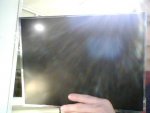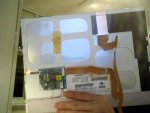Westy has given a example here of the problems driving GLCDs.
His code takes a couple seconds just to update a few hundred pixels.
A flat-out PIC could probably do the same 10 to 20 times faster, but even so, imagine the speed (or lack of it) for thousands of pixels.
Even for small/medium sized colour GLCDs the PIC struggles (as there are more control lines)and then there are memory issues.
George, unless you can find a driver chip, then put your Dad's notebook back together again!! Driving GLCDs can be a real bitch and very time consuming, believe me. And, sadly, it involves reading Manuf's Data Sheets and understanding timing diagrams.
Summary: Direct drivng of big GLCD with PICAXE: forget it. If Stan can't get it onto a breadboard then you have no chance.
PS. Stan , can we have some nice new (tidied-up) images of breadboards for 2009 please?
With nicer fonts for the labelling. Some of those other ones look like my Dad's 1970s Dymo.

Happy Christmas!


